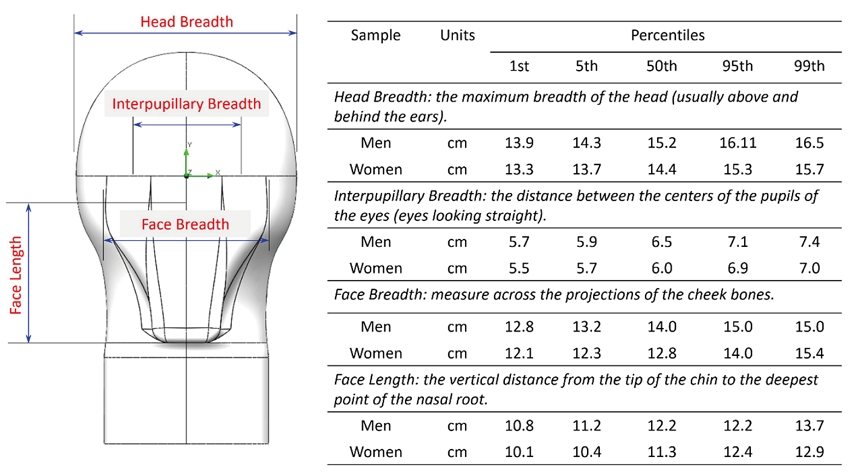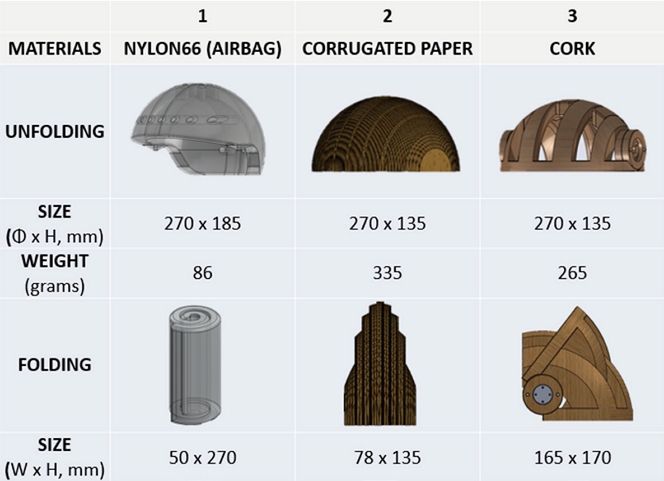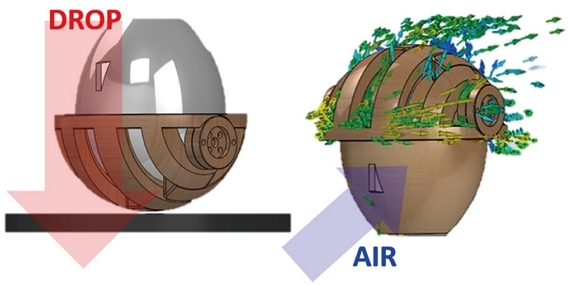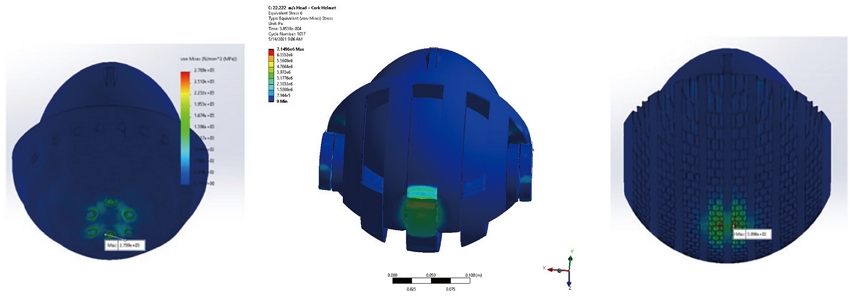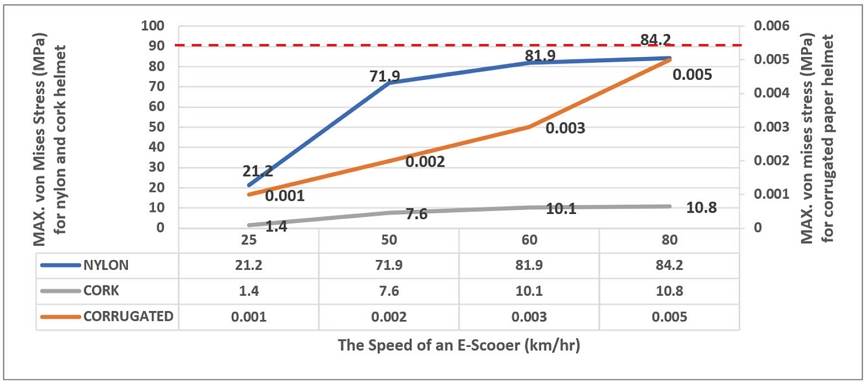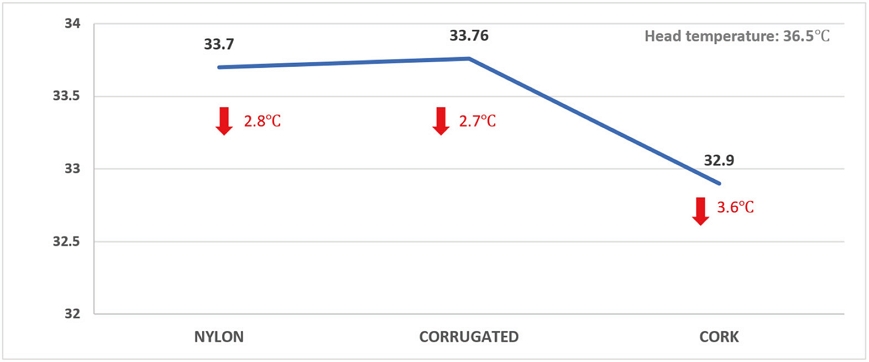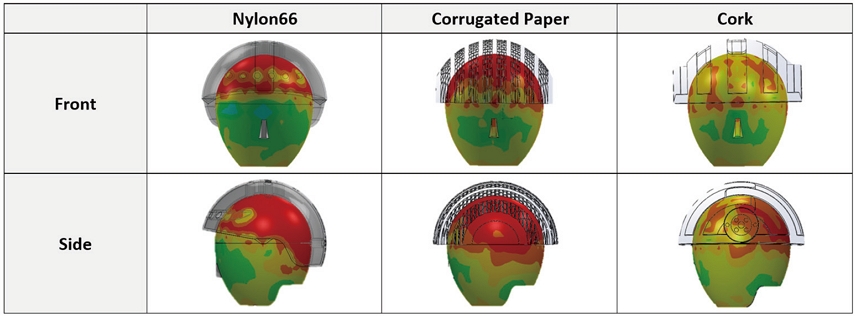
Designing Foldable Helmets for Micro-mobility using Sustainable Materials
Abstract
Background Micro-mobility is a form of transportation that travels short distances using lightweight vehicles such as e-scooters or e-bicycles. Micro-mobility is now prevalent in major cities worldwide and is seen by many users of urban areas as an alternative to motor vehicle transport. Micro-mobility offers considerably higher speeds than walking, is more environmentally friendly and convenient than driving, and does not require expensive car-parking facilities. A helmet is vital personal protective equipment that significantly reduces the risk of head injuries resulting from falling while using micro-mobility services. However, many users do not use a helmet or wear a traditional bicycle helmet despite the much higher speeds while riding micro-mobility. By considering user behavior, designing micro-mobility helmets should consider protecting riders' head injuries, wearing comfort, and maximizing the portability to be easy to carry. In addition, from an environmental perspective, the material used for the current mobility helmet market is far from eco-friendly. As user demand increases, it is time to examine the application of sustainable materials for helmet production. To meet the aim of this study, we explore the various materials to satisfy the essential function of helmets for riders of micro-mobility (e.g., safety, comfortability, portability) along with promoting sustainability. This study seeks to encourage more riders to wear helmets while using micro-mobility to prevent head injuries. Therefore, the developed helmet should be easy-to-carry, comfortable to wear, lightweight and portable.
Methods To promote the use of environmentally friendly products, this study evaluated various eco-friendly materials that can design a highly portable form of the final product at the design stage. This study considered two sustainable materials for helmet production: corrugated cardboard and cork and one recyclable material, Nylon 66, from automobile airbags. Finally, using finite element analysis (FEA) and computational fluid dynamics (CFD) analysis, this study tested all the proposed final designs to examine if the designed helmets meet the applicable safety standards and their functional requirements.
Results The FEA analysis showed that the corrugated paper helmet was superior in relation to the stress on a rider's head, recorded as 5KPa at 80km/h. The CFD analysis revealed that the cork helmet showed better performance in terms of the temperature of a rider's head. The cork helmet reduced the temperature by 3.6℃ from an initial head temperature set at 36.5℃.
Conclusions Considering broad design factors, portability, cooling capacity, and eco-friendliness, corrugated paper was the most suitable helmet material for producing micro-mobility users. However, future work should consider more aesthetic and stylistic elements of helmet design.
Keywords:
Micro-mobility Helmet Design, Urban Transport, Head Injury, Finite-element Analysis, Computational Fluid Dynamics1. Introduction
In urban cities with high density, many problems arise due to dependence on the use of cars, such as traffic congestion, noise pollution and the lack of parking areas. Transportation policies and programs that have been implemented to alleviate such problems, such as subsidised bus fares, typically focus on reducing the use of personal vehicles and boosting public transportation simultaneously. However, more recently, shared micro-mobility services, such as e-scooter or e-bicycle rentals, have been introduced at scale (Campbell et al., 2016). In New Zealand (NZ), the government permitted three commercial micro-mobility companies, Lime, Beam and Flamingo, to run their e-scooter/e-bicycle businesses since 2018, offering services in five cities: Auckland, Christchurch, Dunedin, Hamilton, and Queenstown. According to Auckland Council's (2019) assessment of the rental e-scooter trial, many riders used a shared e-scooter service in Auckland in four months in 2019: total ridership steadily increased from 19,000 to 26,000, and the number of rides taken by Aucklanders via shared mobility systems had also grown 1.5 times from 35,000 to 59,000 times. Each scooter was used about nine times per day on average during that period. The shared e-scooter service in NZ has rapidly become an accepted form of urban transport.
Currently, the micro-mobility, e-scooter and e-bicycle can be driven on both roads and footpaths, which has caused additional issues such as traffic accidents and disturbance to the pedestrian environment (Choo, 2021). Störmann's (2020) study of the injury patterns in Germany due to e-scooter accidents shows that the main areas of the body where riders are likely to get injured are the upper extremities and head. Their study, undertaken for nine months in two city hospitals, found that 28 out of the 76 patients (38%) with e-scooter injuries were injured on the head or face. Whilst these involved various injury patterns, head injuries are the most severe, as they can include life-changing traumatic brain injuries. Since most injuries were caused by riders who tended not to wear a helmet, the author emphasised the importance of helmets as a protective device: only one rider was wearing a helmet, and nine riders were unaware of helmets. Moreover, five riders in the study were injured in a collision with a car. Therefore, a helmet should be designed to protect against the impact of falling from the e-scooter to the ground and secondary impacts with motor vehicles.
Despite recent deaths and accidents involving micro-mobility use, helmets are recommended but are not a legal requirement in many counties. Governments and road authorities in several countries have introduced mandatory helmets for riders and plan to update rules and minimum technical standards for micro-mobility. In South Korea, personal electric vehicles are classified as motorcycles under the country's Road Traffic Act. All e-scooter riders must be at least 16 years old, should have a motorcycle license, and wear a helmet is mandatory. In Denmark and Spain, the government have legislation regarding personal mobility, such as safety regulations, technical standards and mandatory helmets from 2022. In Norway, helmets are compulsory for riders up to the age of 15.
Despite increasing evidence of the risks of using micro-mobility in NZ, there are no regulations related to the speed of an e-scooter and wearing a helmet. Hence, many riders are injured whilst riding e-scooters in NZ. Brownson et al. (2019) examined the pattern of injuries from e-scooter use in Auckland. Their study analysed 180 Auckland City Hospital Emergency Department patients for 19 weeks, reflecting an average of 1.4 patient admissions per day due to e-scooter accidents. The leading cause of injury was a single fall from an e-scooter, accounting for approximately 93% of patients. Five cases of those were secondary accidents involving a collision with a car or a pedestrian. The study identified the significant injuries as head injuries, fractures, lacerations, and sprains, with head injuries accounting for 17.2% of the total injuries or 31 patients. What is striking in this study is that only three of the 180 patients wore a helmet, equivalent to only 1.7%. A low tendency to wear a helmet is not surprising for shared micro-mobility services: riders use them for convenience and do not carry helmets with them if they need to use a micro-mobility. Moreover, whilst most people are not concerned about sharing a micro-mobility with many other users, fewer people like to share a helmet, even if the micro-mobility service provides these. Consequently, there is a need for portable, high-quality helmets riders can use to protect themselves from severe head injuries during accidents.
Accidents using a micro-mobility impose significant personal harm to the rider and are costly to the government. In NZ, accidents involving personal injury are covered by a no-fault accidental injury compensation scheme run by the Accident Compensation Corporation (ACC), an NZ Crown entity. Using ACC Claims data, Bekhit et al. (2020) evaluated e-scooter-related injuries treated by healthcare providers in the Auckland region of NZ across seven months between 2018 and 2019. This study examined the types of injuries and the overall hospital burden from these injuries with their financial costs. The study investigated 770 patient presentations related to e-scooters, 524 (68.1%) patients were treated by primary care physicians in the community, while 246 (31.9%) were treated by Auckland hospitals. The 246 hospital presentations used a total of 5,569 hospital bed hours, with 75 patients (30.5%) requiring admission to inpatient care and 49 patients (19.9%) requiring at least one operation. 105 out of the 246 hospital presentations (42.7%) follow-up of specialists needed treatment. Alcohol was judged to be responsible for 26.8% of the injuries. The predicted injury rate was 60 per 100,000 visits, with a 20 per 100,000 trip hospital presentation rate. The combined cost of these accidents was calculated at NZ$ 1,303,155 for the Auckland Region, with Auckland City Hospital incurring NZ$ 608,843.
Similarly, Faryabi et al. (2014) investigated why many motorcyclists do not wear a helmet in Iran, conducting interviews with patients admitted by emergency to the hospital. Their study found that only 21.5% of patients wore helmets. The most common reason for not wearing a helmet was because of the weight of the helmet. Since the helmet is heavy, motorcyclists felt uncomfortable wearing one, even though they risked a severe or fatal injury without a helmet. Molina-García et al. (2016) studied the impact of mandatory laws given to adolescents to wear helmets when they cycle to school. This study interviewed 266 students who cycle to school in Valencia, Spain and found that barriers to wearing a helmet could be narrowed down to peer influence, a bicycle-sharing program, and annoyance. Annoyance means that they feel discomfort in carrying the helmet everywhere they go. Since riders have to carry it around all day after arriving at the final destination, this study concluded that this is why students should not wear helmets at all. Hence, a lightweight and portable helmet is needed to prevent resistance to wearing a helmet.
Many factors are associated with designing a personalised helmet for the user of micro-mobility. For developing specifically designed helmets for micro-mobility users and their corresponding form factors, this study considered three design conditions to explore: head safety, portability and eco-friendliness.
Despite the growing emphasis on the safety of the use of owned or shared micro-mobility, there are no specific guidelines for designing a micro-mobility helmet in terms of materials or structures, as long as manufacturers or designers can guarantee that the helmet is protective and can pass the tests under the bicycle helmet standard, which is AS/NZS 2063 in NZ (Towner et al., 2002). Protecting the user's head and preventing severe brain injuries and skull fractures are the essential functions of a helmet. Each designed helmet was tested in two mechanical engineering analyses to meet the functional requirements: a Finite Element (FE) and Computational Fluid Dynamics (CFD) analysis. FE analysis is a computerised method for predicting how a product reacts to physical forces such as mechanical forces and stress. FE is an engineering tool to predict the behaviour of designed helmets during their future use and forecast the risk of failure, speed of impact and correct helmet thickness right from the design stage. In addition, using the Computational Fluid Dynamics (CFD) method, all the proposed designs were tested with various mechanical characteristics such as comfort, convenience, and ventilation.
Inconvenience is a significant obstacle to helmet use by riders of shared vehicles (Serra et al., 2021). The collapsible and folding helmets could make helmet use more frequent for occasional riders or who may want to use a shared micro-mobility for recreational purposes (Kobayashi et al., 2019; Sparks et al., 2019; Serra et al., 2021). The proposed helmets in this study are designed to maximise portability: so that riders can conveniently bring the helmet with them to use when riding a micro-mobility to avoid the issue of sharing helmets with a shared service. This study also considered another problem identified by personal use of helmets, mainly the helmet’s weight on the head. The material selection criterion is also important when considering environmental hazards since Expanded Polystyrene (EPS) foam or plastics are the most used hamlet's inner and outer shells that take several hundred years to decompose (de Oliveira et al., 2019; Lithner et al., 2011). In this paper, we present three conceptual designs of helmets that are lightweight, convenient and portable, made of sustainable or recycled materials and entail different form factors.
2. Literature Review
In designing a helmet, the material used to construct it is a critical decision because it can affect the performance of absorbing impacts. One of the most cost-effective materials utilised to produce the helmet's inner liner is Expanded Polystyrene (EPS), with its lightweight and outstanding energy absorption capability. However, these helmets have limited effectiveness in preventing brain injuries. Thompson et al. (1989) and Bambach et al. (2013) showed that wearing the EPS helmet decreases the risk of severe head injury by approximately 75%. However, the reduction in traumatic brain injury rates is statistically insignificant. Bliven et al. (2019) also revealed that traditional EPS bicycle helmets are not highly effective in preventing skull fractures under the high linear acceleration of a head form. Despite EPS forms being significantly better material for some products where weight is the primary design factor, the environmental aspect should not be ignored.
Production using recyclable or sustainably produced materials is essential for environmental sustainability. Therefore, manufacturers should consider their products' environmental impact and take steps towards reducing their impact on the planet. Traditional materials used in helmet production, such as plastic, can significantly impact the environment. By using environmentally friendly materials, manufacturers can reduce the amount of waste and pollution generated during manufacturing. In addition, using sustainable materials promotes using renewable resources and reduces the reliance on non-renewable resources. This can help to create a more sustainable future and protect the planet for future generations. Some traditional materials used in helmet production, such as polycarbonate plastic, can contain harmful chemicals that pose health risks. Using environmentally friendly materials can help to reduce exposure to these chemicals and promote healthier living. Some environmentally friendly materials, such as cork or bamboo, can have superior shock absorption properties compared to traditional materials. This can improve the helmet’s performance and provide better protection for the wearer. Finally, consumers are increasingly concerned about the environmental impact of their products. By using environmentally friendly materials, manufacturers can appeal to these consumers and differentiate themselves in the market. Here are some materials that can be used for eco-friendly helmet production:
- • Cork and Bamboo: Cork is a sustainable material that is lightweight, durable, and provides good shock absorption. It is a renewable resource that can be harvested without harming the trees, making it an excellent choice for helmet production. Bamboo is another renewable resource that is strong, lightweight, and biodegradable. It is also a fast-growing plant, making it an excellent choice for sustainable manufacturing.
- • Linen and Hemp: Linen is a natural fibre that is strong, lightweight, and breathable. It is also biodegradable and can be grown without pesticides or herbicides. Hemp is another natural fibre that is strong, durable, and lightweight. It is also a fast-growing plant that requires fewer resources than other crops.
- • Recycled Plastic and EPS: Using recycled plastic is an excellent way to reduce waste and promote sustainability. It can produce helmet shells, reducing the need for virgin plastic. EPS (expanded polystyrene) is commonly used in helmet production. Using recycled EPS reduces waste and the environmental impact of manufacturing.
As mentioned above, cork is one of the more sustainable materials with a high capacity for absorbing impacts. Park (2015) revealed in his study of cork properties that cork is a natural material with a micro-pore structure, making it very durable against heat, noise, and vibration. Moreover, it has very high impact resistance because the cell membrane of the cork is very flexible. The flexible cell membrane structure contributes to the material's high energy absorption capacity and vibration-damping performance. Therefore, cork has received significant research attention recently because of its unique features, such as energy absorption and a high viscoelastic return (Fernandes et al., 2019; Tay et al., 2014; Coelho et al., 2013; Alves de Sousa et al., 2012). Cork can be utilised for various applications such as helmets, vehicle safety devices and armour. Consequently, cork is a promising material for a helmet because of its functionality and eco-friendliness.
Another option for creating environmentally friendly helmets is to use recycled materials. Due to the increasing number of motor vehicles produced globally, many studies have focused on the negative environmental impact of disposing of End-of-Life Vehicles (ELVs) (Cassells, 2004). Hence, many countries have been trying to recycle the parts from ELVs. In NZ, approximately 128,000 passenger cars are de-registered every year. If the parts from ELVs are not recycled, this will have a detrimental impact on the environment. Whilst some parts can be recycled for scrap metal or as spare parts on the second-hand market, safety components such as airbags cannot be sold as part of the wrecking process. However, it may be possible to use these materials in new ways. Nylon 66 is the primary material used in the manufacture of airbags and, if recycled from ELVs, can be used as a material for a helmet (Sun & Barnes, 2003). The primary role of the airbag is to protect drivers from the impact of crashes. Since Nylon 66 shows superior energy absorption compared to other polymers, it has dominated the market for the material used for an airbag during the past few decades. Nylon 66 has many advantages over other alternative airbag materials, such as polyester: it is 17% lower in density (making it lightweight). It has a higher specific heat capacity (making it more resistant to melting from heat). Nylon 66 also ages slowly, which is why it is widely used to manufacture airbags, which must have a replacement period of at least 15 years. Using Nylon 66 in the recycling phase is also beneficial. Users may also be more favourable towards this material because it is generated from recycling and is used as a safety mechanism in each case. Hence, in terms of the helmet, Nylon 66 is one of the most suitable materials because it is excellent in absorbing energy, is lightweight, and is durable against heat as it can endure the heat from an inflator for an airbag. However, one potential disadvantage of Nylon 66 is its low permeability, which means it cannot contain the air for long. Hence, there needs to be some solution to avoid leaking air while riding a micro-mobility.
Ahn et al. (2009) investigate the gas permeability of nylon and polyester in developing floating bag materials for boats. They test the nylon and polyester with liquid silicon rubber on a recreational boat using different coating thicknesses: 30, 50 and 70 micrometres. Nylon showed better performance in keeping the gas inside the boat than polyester. Their experiments showed that nylon with a 70-micrometre liquid silicon rubber coating kept up to 89% of the gas in the nylon 4 hours after injecting it. Most users ride a micro-mobility vehicle within a distance of 2km (Fitt and Curl, 2019). This implies that over 85% of the air would stay in the helmet during a typical ride. Nylon 66 needs to be coated by silicon with 70 micrometres to keep the air inside a helmet. Hence, this process may require reinflating the helmet for each ride.
Finally, the third potential material is corrugated paper which has been broadly used and studied as packaging material for various goods. McQuade (2015) has researched and designed helmet designs for bicycle users that are either recyclable or disposable. They noted that moulded pulp is utilised in the packing industry due to its cushioning effect and recyclable properties, making it similarly useful for helmet design. Gilchrist et al. (1999) also note that corrugated paper is favoured for protection during goods' transportation because of its high strength-to-weight ratio and as an eco-friendly material. Park et al. (2020) also illustrate that corrugated paper helmets perform better than polystyrene in a crash test. Another interesting takeaway is that the cross structure is more flexible than the EPS design. Based on this, the corrugated paper would be possible to make an eco-friendly helmet able to enhance rider safety.
3. A conceptualisation of the helmet
A well-constructed helmet is considered to have excellent functional characteristics and design. Ergonomic factors must be considered when constructing a bicycle helmet, irrespective of the material chosen, as ergonomics affect the users' comfort in wearing the helmet. Figure 1 illustrates ergonomic measures of the helmet design for this study adopted from Boshevski et al. (2017). Boshevski et al. (2017) stressed that the body sizes of the most minor and most prominent representative of the selected users’ population direct influence the product’s dimensions for adult users, both men and women. Therefore, the construction of the 3D model for any helmet starts from the interior layer of the helmet, considering the head breadth dimension, the face breadth and face length dimensions using the data presented in Figure 1, which have been constructed on human engineering design data digest.
In this study, three types of helmets were designed from the materials discussed earlier, shown in Figure 2. The concept of these helmets was inspired by other goods such as folding paper furniture, an airbag from a vehicle and interlocking fingers.
For the helmets to be foldable, many mechanisms are used, such as blowing the air into a bag for Nylon 66, a honeycomb structure for corrugated paper and an interlocking structure for cork. Moreover, to design ergonomic helmets, these helmets were designed based on the 95th percentile for static human physical characteristics for universal usage. When it comes to weight, all helmets are lightweight and comparable to the helmets used for traditional bicycles. The corrugated paper helmet weighs 335 grams, just 10% higher than a bicycle helmet's average weight, around 300 grams. In terms of folding size, the Nylon 66 and corrugated paper helmets can be folded to reduce the size by 70% of their in-use shape, while the cork helmet can only be reduced by around 25%.
4. The FEA and CFD of analysis
Before constructing the prototype helmet, conducting a virtual safety simulation is essential. Compared to a trial-and-error approach, the computational modelling process significantly saves time and material costs. Boshevski et al. (2017) illustrated the simulation process of the impact test used to determine whether the helmet can protect the user's head from impact, which should be conducted before building the prototype. The classification of the helmet impact test is based on the EN 1078 standard of a male head in accurate, ergonomic dimensions, which are aligned with the standard to create the 3D model. The 3D model for the user is created based on the dimensions given in Figure 1 using the 95th percentile for men using the following values: head breadth (16.11 cm) and the face length (12.2 cm) with a head dummy weight of 9 kg using an impact relative velocity of 6.7 m/s. In this paper, the virtual impact tests are undertaken using Solidworks's Finite Elements Analysis (FEA). The FEA displays the stress which a material undergoes through the von Mises stress field, which shows the stresses subjected to each helmet and the user's head. The properties of materials taken from previous studies are shown in Table 1.
The property of the human skull is extremely important and must be thoroughly studied to determine the severity level of head injury. Kleiven's (2007) study shows the impact on people and the properties of a human head through FEA analysis. The impact test is conducted in the downward direction, similar to the method of testing protective helmets (Figure 3). Since the regulatory maximum speed of an e-scooter in NZ is about 25km/h, which can be faster when going downhill, the test should be conducted at various speeds above the recommended speed. Moreover, to account for the possibilities of secondary accidents caused by collision with a motor vehicle, the velocity of the impact test ranges between 25km/h and 80km/h. This enables the selection of the safest helmet from the simulation results.
As explained earlier, a key reason why people choose not to wear a helmet is discomfort mainly caused by heat due to the lack of ventilation of the helmet. Therefore, examining and verifying the helmet's degree of ventilation is essential. The virtual test is conducted with Solidworks Flow Simulation (CFD). This study uses the boundary conditions for flow simulation of the helmet described in Boshevski et al. (2017) consisting of atmospheric pressure (101,325 Pa) and temperature (22℃) (See Table 2). The ride duration was determined by the Auckland City Council (2019) report and selected to be 10 minutes, as the average time spent on a micro-mobility is less than 10 minutes.
The heat that people experience while riding a micro-mobility can be related to the thermal property of the material used for the helmet. Since the material with high thermal conductivity can quickly reduce the head temperature by emitting heat from the head outwards, it should be considered in this analysis. Table 3 displays the thermal conductivity interpolated from Sun & Barnes (2003) and Cherki et al. (2014).
5. Results
The impact tests were performed at the following velocities: 25, 50, 60 and 80km/h. Figure 4 illustrates that the stress on a rider must not exceed the yield stress of the skull because being over the yield stress implies severe damage to the head could occur. Moreover, the further the stress on a rider is from the yield stress, the safer the head is.
Figure 5 demonstrates that all helmets are below the yield stress of the skull. Hence all helmets show sufficient head protection from impact across the entire range of velocities. Notably, the corrugated paper helmet performs better than the other helmets in the impact test. Its maximum stress is just 5 KPa, and the stress difference between the maximum and minimum velocities is only 4 KPa, which shows that corrugated paper can absorb almost all impacts before transmitting it to the head. The cork helmet also demonstrates excellent performance, while its stress on a rider was estimated to be nine times lower than the yield stress of the skull at 80 km/h, which is 10.8 MPa. However, in the case of the nylon helmet, it shows a tendency to increase the stress on a rider with increasing velocity. At 80km/h, its stress is very close to the yield stress, 84.2 MPa. Therefore, the nylon helmet could protect a head from accidents without external impacts. However, it can be concluded that it may be vulnerable to secondary impact by a vehicle or object. Hence, in terms of the safety aspect, corrugated paper and cork are more suitable materials for the micro-mobility helmet than Nylon 66.
Figure 6 shows the average head temperature results while riding a micro-mobility. The cork helmet has a superior cooling capacity to the other helmets, which can reduce the head temperature by up to 3.6℃. Other helmets show similar cooling capacity, as nylon and corrugated paper demonstrated cooling of 2.8℃and 2.7℃, respectively.
Figure 7 illustrates the distribution of the head temperature while riding a micro-mobility. For all helmets, the back of the head tends to be higher in temperature than the front, as the front of the head is exposed to cooling air currents as the rider moves forward. Based on the analysis, the cooling capacity depends on the area exposed to the air rather than its thermal conductivity. Although Nylon 66 has the lowest thermal conductivity, it shows a similar capacity to the corrugated helmet. There are only a few areas exposed to the air in the case of both nylon and corrugated helmet, while the cork helmet has a lot. Consequently, this study can be concluded that the material selection is more critical for cooling in relation to the helmet design.
6. Evaluation
The corrugated paper helmet is the most suitable for a micro-mobility helmet. Figure 8 exhibits that the corrugated paper helmet showed superior performance in the safety test with 84.2 MPa maximum Von Mises stress (as shown in Figure 5), which is the most critical factor in achieving the fundamental purpose of the helmet. In terms of physical shape, including weight, size and volume, this helmet was similar in weight (335 grams) to the average bicycle helmet. Still, it can be folded significantly (70% in volume) 286,570.12 mm3 (as shown in Figure 2), so a rider can easily carry it after using a micro-mobility. The corrugated paper rated the lowest performance in relation to cooling capacity and comfort at 33.76℃ (as shown in Figure 6) but performed well in all other factors compared to the other helmets.
The cork helmet also demonstrated outstanding performance in all sectors. However, the downside to cork was its limited portability: the cork helmet can only be reduced by 25% from an in-use condition, which has less of a convenience advantage over traditional helmets, hence may lead to the same issues where riders do not feel like carrying it around. If riders do not see the value in using the helmet due to its portability, it is useless regardless of its safety. Hence, for the cork helmet to be acceptable, it must be improved in terms of convenience. Finally, although it is the most lightweight and convenient, the nylon helmet performs worst in the safety sector. Since the helmet should protect the head in case of unexpected accidents, it needs to be improved significantly, especially at high velocity, by changing the helmet design or material.
7. Conclusion
This paper shows the design process of a helmet for micro-mobility. This paper aims to design the helmet for micro-mobility, which addresses the main reasons why riders do not wear helmets and resolves them. There were four main reasons for resistance to helmet use: weight, portability, ventilation, and safety. Furthermore, due to rising environmental concerns, recyclable or sustainable materials were only considered for designing helmets: Nylon 66, corrugated paper and cork. After designing, virtual simulations were conducted using CFD and FEA analyses to verify the characteristics of each helmet to determine the performance and rank of which helmet is the most suitable for the micro-mobility user environment.
In conclusion, the corrugated paper helmet performed exceptionally in all functional criteria. However, since it is solely based on computational modelling, real-life tests must be conducted to determine whether the results from virtual tests are reliable. The actual test results may differ from the virtual tests as the user's weight has not been considered. Moreover, many other important factors, such as price and marketability, should be conducted to reach customers. This paper can lead to further study for emphasising aesthetic and stylistic aspects of helmet design.
Acknowledgments
This research was supported by the KNUDP (Korea National University Development Project) funded by the Ministry of Education (MOE, Korea) and National Research Foundation of Korea(NRF) and partially supported by the Te Pūkenga - Waikato Institute of Technology, New Zealand
Notes
Copyright : This is an Open Access article distributed under the terms of the Creative Commons Attribution Non-Commercial License (http://creativecommons.org/licenses/by-nc/3.0/), which permits unrestricted educational and non-commercial use, provided the original work is properly cited.
References
- Ahn, T. K., Park, C. H., & Ko, H. N. (2009). Study on the Floating bag Materials for Boats. In Proceedings of the KAIS Fall Conference (pp. 368-371). The Korea Academia-Industrial cooperation Society.
-
Alves de Sousa, R. J., Gonçalves, D. F. S., Coelho, R. M., & Teixeira-Dias, F. M. V. H. (2012). Assessing the effectiveness of the use of a natural cellular material as safety padding in motorcycle helmet. Simulation: Transactions of the Society for Modeling and Simulation International, 88(5), 579-590.
[https://doi.org/10.1177/0037549711414735]

- Auckland City Council (2019). Rental e-scooter trial 2.0: Results, evaluation and recommendations.
-
Bambach, M. R., Mitchell, R. J., Grzebieta, R. H., & Olivier, J. (2013). The effectiveness of helmets in bicycle collisions with motor vehicles: A case-control study. Accident Analysis & Prevention, 53, 78-88.
[https://doi.org/10.1016/j.aap.2013.01.005]

-
Bekhit, M. N. Z., Le Fevre, J., & Bergin, C. J. (2020). Regional healthcare costs and burden of injury associated with electric scooters. Injury, 51(2), 271-277.
[https://doi.org/10.1016/j.injury.2019.10.026]

-
Bliven, E., Rouhier, A., Tsai, S., Willinger, R., Bourdet, N., Deck, C., Madey, S. M., & Bottlang, M. (2019). Evaluation of a novel bicycle helmet concept in oblique impact testing. Accident Analysis & Prevention, 124, 58-65.
[https://doi.org/10.1016/j.aap.2018.12.017]

-
Boshevski, B., & Mircheski, I. (2017). Bicycle helmet design and the virtual validation of the impact, aerodynamics and production process. Facta Universitatis, Series: Mechanical Engineering, 15(3), 353-366.
[https://doi.org/10.22190/FUME170928019B]

- Brownson, A. B., Fagan, P. V., Dickson, S., & Civil, I. D. (2019). Electric scooter injuries at Auckland City Hospital. NZ Med J, 132, 62-72.
-
Campbell, A. A., Cherry, C. R., Ryerson, M. S., & Yang, X. (2016). Factors influencing the choice of shared bicycles and shared electric bikes in Beijing. Transportation research part C: emerging technologies, 67, 399-414.
[https://doi.org/10.1016/j.trc.2016.03.004]

- Cassells, S. M. (2004). Toward sound management of end-of-life vehicles in New Zealand: a thesis presented in partial fulfilment of the requirements for the degree of Doctor of Philosophy in Economics, Massey University, Palmerston North, New Zealand (Doctoral dissertation, Massey University).
-
Cherki, A. B., Remy, B., Khabbazi, A., Jannot, Y., & Baillis, D. (2014). Experimental thermal properties characterization of insulating cork-gypsum composite. Construction and building materials, 54, 202-209.
[https://doi.org/10.1016/j.conbuildmat.2013.12.076]

-
Choo, S. (2021). Study on Shared E-scooter Usage Characteristics and Influencing Factors. The Journal of The Korea Institute of Intelligent Transport Systems, 20(1), 40-53.
[https://doi.org/10.12815/kits.2021.20.1.40]

-
Coelho, R. M., de Sousa, R. A., Fernandes, F. A. O., & Teixeira-Dias, F. M. V. H. (2013). New composite liners for energy absorption purposes. Materials & Design, 43, 384-392.
[https://doi.org/10.1016/j.matdes.2012.07.020]

-
de Oliveira, C. T., Luna, M. M., & Campos, L. M. (2019). Understanding the Brazilian expanded polystyrene supply chain and its reverse logistics towards circular economy. Journal of Cleaner Production, 235, 562-573.
[https://doi.org/10.1016/j.jclepro.2019.06.319]

-
Faryabi, J., Rajabi, M., & Alirezaee, S. (2014). Evaluation of the use and reasons for not using a helmet by motorcyclists admitted to the emergency ward of Shahid Bahonar hospital in Germany. Archives of trauma research, 3(3).
[https://doi.org/10.5812/atr.19122]

-
Fernandes, F. A., Alves de Sousa, R. J., Ptak, M., & Migueis, G. (2019). Helmet design based on the optimization of biocomposite energy-absorbing liners under multi-impact loading. Applied Sciences, 9(4), 735.
[https://doi.org/10.3390/app9040735]

-
Fernandes, F. A. O., Pascoal, R. J. S., & de Sousa, R. A. (2014). Modelling impact response of agglomerated cork. Materials & Design, 58, 499-507.
[https://doi.org/10.1016/j.matdes.2014.02.011]

- Fitt, H., & Curl, A. (2019). E-scooter use in New Zealand: Insights around some frequently asked questions. University of Canterbury: Christchurch, New Zealand. Retrieved August 21, 2020.
- Gilchrist, A. C., Suhling, J. C., & Urbanik, T. J. (1998). Nonlinear finite element modeling of corrugated board. ASME Applied Mechanics Division-Publications-AMD, 231, 101-106.
- Kim, G. (2020). The Analysis of Injury Risk for the Type of Accident by Personal Mobility. Journal of Auto-vehicle Safety Association, 12(1), 6-14.
- Kleiven, S. (2007, June). A parametric study of energy absorbing foams for head injury prevention. In The 20th International Technical Conference on the Enhanced Safety of Vehicles Conference (ESV), Lyon, France (pp. 18-21).
-
Kobayashi, L. M., Williams, E., Brown, C. V., Emigh, B. J., Bansal, V., Badiee, J., ... & Doucet, J. (2019). The e-merging e-pidemic of e-scooters. Trauma surgery & acute care open, 4(1), e000337.
[https://doi.org/10.1136/tsaco-2019-000337]

-
Lithner, D., Larsson, Å., & Dave, G. (2011). Environmental and health hazard ranking and assessment of plastic polymers based on chemical composition. Science of the total environment, 409(18), 3309-3324.
[https://doi.org/10.1016/j.scitotenv.2011.04.038]

- McQuade, S. R. (2015). Recyclable disposable helmet design (Unpublished Bachelor's thesis). University of Southern Queensland, Australia.
-
Molina-García, J., & Queralt, A. (2016). The Impact of Mandatory Helmet-Use Legislation on the Frequency of Cycling to School and Helmet Use Among Adolescents. Journal of Physical Activity & Health, 13(6), 649-653.
[https://doi.org/10.1123/jpah.2015-0566]

-
Park, J., Park, M., Choi, D. S., Jung, H. M., & Hwang, S. W. (2020). Finite element-based simulation for edgewise compression behaviour of corrugated paperboard for packaging of agricultural products. Applied Sciences, 10(19), 6716.
[https://doi.org/10.3390/app10196716]

- Park, S. J. (2015). Experimental Investigation on Thermal-Mechanical Properties of Cork Particulate Polyurethane Composite Foams (Unpublished master's thesis). Sungkyunkwan Univesity, Seoul, Korea.
-
Störmann, P., Klug, A., Nau, C., Verboket, R. D., Leiblein, M., Müller, D., Schweigkofler, U., Hoffmann, R., Marzi, I. & Lustenberger, T (2020). Characteristics and injury patterns in electric-scooter related accidents-a prospective two-centre report from Germany. Journal of clinical medicine, 9(5), 1569.
[https://doi.org/10.3390/jcm9051569]

-
Serra, G. F., Fernandes, F. A., Noronha, E., & de Sousa, R. J. A. (2021). Head protection in electric micromobility: A critical review, recommendations, and future trends. Accident Analysis & Prevention, 163, 106430.
[https://doi.org/10.1016/j.aap.2021.106430]

-
Sparks, A. M., Fessler, D. M., & Zinsser, M. (2019). Exploring the Roles of Conformity, Hazard, and Convenience in Risk Mitigation Decisions: An Observational Study of Helmet Use Among Bicyclists and E-Scooter Riders in Los Angeles During Two Natural Experiments.
[https://doi.org/10.31234/osf.io/gspbm]

- Sun, J., & Barnes, J. A. (2003). Materials Selection for Airbag Fabrics. Airbag End-Use Technology, DuPont Textiles and Interiors.
-
Tay, Y. Y., Lim, C. S., & Lankarani, H. M. (2014). A finite element analysis of high-energy absorption cellular materials in enhancing passive safety of road vehicles in side-impact accidents. International Journal of Crashworthiness, 19(3), 288-300.
[https://doi.org/10.1080/13588265.2014.893789]

-
Thompson, R. S., Rivara, F. P., & Thompson, D. C. (1989). A case-control study of the effectiveness of bicycle safety helmets. New England journal of medicine, 320(21), 1361-1367.
[https://doi.org/10.1056/NEJM198905253202101]

- Towner, E., Dowswell, T., Burkes, M., Dickinson, H., Towner, J., & Hayes, M. (2002). Bicycle helmets: a review of their effectiveness: a critical review of the literature. The Department.
